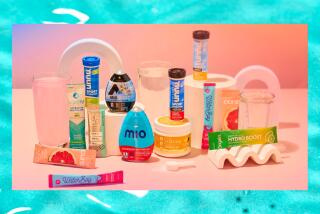One Key to Prevention: Watch Your Sweat
- Share via
To protect yourself against hyponatremia, start by paying attention to how much you sweat.
In general, women sweat less than men and their ability to regulate core body temperature (and sweating) may vary with different phases of the menstrual cycle. Individuals also vary considerably in how much sodium they lose in sweat. You may be a heavy sodium loser if your sweat burns your eyes, tastes salty or leaves a cakey-white residue on your skin. Sweat contains one to two grams of sodium per liter--and since it’s easy to lose a liter of perspiration in a long race, that means you’re losing this much sodium too.
You can replace two grams of sodium with about a half-teaspoon of salt. You can also make sure you’re getting enough sodium by drinking sports drinks such as Accelerade, Cytomax, Gpush or Gatorade instead of plain water during long events. (Check the labels for sodium content; some brands have twice the sodium of others.)
Sports drinks also typically contain carbohydrates, which provide energy and help with water and sodium absorption. These sports drinks are similar to Pedialyte and other oral rehydration solutions used to treat children who become dangerously dehydrated.
If you don’t like sports drinks, you could take salt tablets, but they may make you nauseated. At the very least, you can eat salty foods before and during a big event.
You can gauge how much fluid you’re losing by weighing yourself before and after half an hour of exercise. (Don’t drink anything between weigh-ins.) If you lose a pound in half an hour, your sweat rate is two pounds per hour, which means you need to replace that much fluid. (Two pounds of fluid is 32 ounces.)
As a practical matter, you’re probably not in any danger from dehydration unless you lose more than 2% to 3% of your body weight during exercise, but you can’t rely on thirst to guide you because by the time you’re thirsty, you may already be dehydrated. So the goal is to adjust your fluid intake to how much you sweat.
In fact, for ordinary mortals who work out for less than an hour, sports drinks are unnecessary--and plain old water (along with the salt you normally get in food) will do just fine, says Roger Fielding, an exercise physiologist at Boston University.
For endurance athletes doing events longer than an hour and sweating profusely, it’s probably wise to drink 6 to 8 ounces of fluid every 20 minutes to prevent excessive dehydration and hyponatremia, says Scott Montain, a research physiologist at the U.S. Army Research Institute of Environmental Medicine.
For events lasting longer than two hours, you’re probably better off with a carbohydrate-electrolyte sports drink than plain water. But don’t drink more than 40 ounces (1 1/4 quarts) per hour--that’s erring toward excess fluid intake, cautions Montain.

